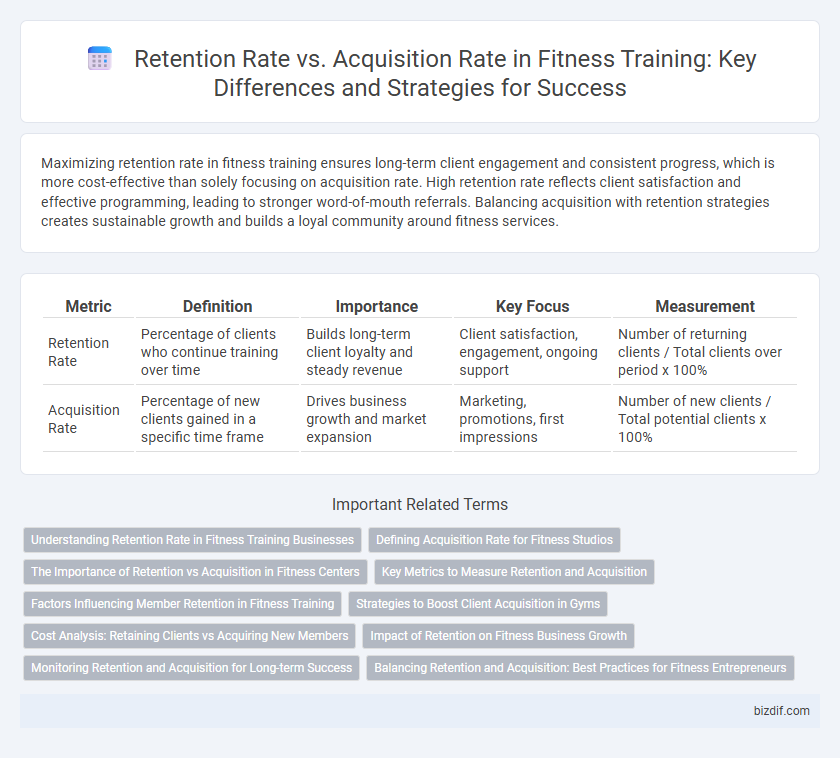Maximizing retention rate in fitness training ensures long-term client engagement and consistent progress, which is more cost-effective than solely focusing on acquisition rate. High retention rate reflects client satisfaction and effective programming, leading to stronger word-of-mouth referrals. Balancing acquisition with retention strategies creates sustainable growth and builds a loyal community around fitness services.
Table of Comparison
| Metric | Definition | Importance | Key Focus | Measurement |
|---|---|---|---|---|
| Retention Rate | Percentage of clients who continue training over time | Builds long-term client loyalty and steady revenue | Client satisfaction, engagement, ongoing support | Number of returning clients / Total clients over period x 100% |
| Acquisition Rate | Percentage of new clients gained in a specific time frame | Drives business growth and market expansion | Marketing, promotions, first impressions | Number of new clients / Total potential clients x 100% |
Understanding Retention Rate in Fitness Training Businesses
Retention rate in fitness training businesses measures the percentage of clients who continue their membership or training programs over a specific period, highlighting customer loyalty and satisfaction. High retention rates indicate effective engagement strategies, personalized coaching, and consistent value delivery, which reduce churn and stabilize revenue streams. Focusing on retention rather than acquisition lowers marketing costs while building a solid community that promotes long-term business sustainability.
Defining Acquisition Rate for Fitness Studios
Acquisition rate in fitness studios refers to the percentage of new members gained within a specific timeframe, reflecting the effectiveness of marketing and promotional efforts. This metric is crucial for understanding how well the studio attracts prospective clients through channels like social media campaigns, referral programs, and targeted advertising. A high acquisition rate indicates successful outreach and growing brand awareness, which directly impacts revenue growth and market expansion.
The Importance of Retention vs Acquisition in Fitness Centers
Retention rate in fitness centers directly impacts long-term revenue stability by ensuring consistent membership renewals, while acquisition rate focuses on attracting new clients to expand the customer base. High retention rates reduce marketing costs and increase lifetime customer value, making it more cost-effective than continuously acquiring new members. Emphasizing member satisfaction, personalized training programs, and community engagement enhances retention, ultimately driving sustainable growth in competitive fitness markets.
Key Metrics to Measure Retention and Acquisition
Retention rate in fitness training measures the percentage of clients who continue their membership over a specific period, indicating long-term satisfaction and program effectiveness. Acquisition rate tracks the number of new clients gained within a timeframe, reflecting marketing success and outreach efficiency. Key metrics to measure retention include membership renewal rates, session attendance consistency, and engagement levels, while acquisition relies on lead conversion rates, trial sign-ups, and promotional campaign performance.
Factors Influencing Member Retention in Fitness Training
High member retention in fitness training is influenced by personalized workout plans, consistent trainer support, and a motivating community environment that fosters accountability. Quality facility amenities, flexible scheduling options, and regular progress tracking also play critical roles in maintaining member engagement. Understanding individual goals and providing continuous encouragement significantly reduce dropout rates and boost overall retention effectiveness.
Strategies to Boost Client Acquisition in Gyms
Implement targeted social media campaigns highlighting real client transformations to increase gym client acquisition rates effectively. Offering referral incentives and trial memberships encourages new sign-ups while building trust and community engagement. Utilizing data analytics to tailor marketing efforts ensures higher conversion by attracting the right demographics aligned with gym services.
Cost Analysis: Retaining Clients vs Acquiring New Members
Retention rate in fitness training significantly lowers overall costs compared to acquisition rate, as acquiring new members often demands higher marketing expenditures and promotional offers. Analyzing cost per client reveals that retaining existing members maximizes lifetime value through reduced onboarding expenses and steady revenue streams. Businesses investing in member retention strategies achieve more sustainable growth by optimizing operational budgets and minimizing churn-related losses.
Impact of Retention on Fitness Business Growth
High retention rates in fitness training significantly enhance business growth by fostering a loyal client base that generates consistent revenue and positive word-of-mouth referrals. Retaining existing members reduces marketing costs compared to constantly acquiring new clients, improving overall profitability. Long-term member engagement leads to better community building and sustained cash flow, making retention a critical metric for scaling fitness businesses effectively.
Monitoring Retention and Acquisition for Long-term Success
Monitoring retention and acquisition rates is essential for long-term success in fitness training, ensuring steady client growth and sustained engagement. High retention rates reflect client satisfaction and effective programming, while acquisition rates indicate successful marketing and outreach efforts. Balancing these metrics provides actionable insights to optimize training plans and business strategies.
Balancing Retention and Acquisition: Best Practices for Fitness Entrepreneurs
Balancing retention and acquisition rates is crucial for fitness entrepreneurs aiming to sustain long-term growth and profitability. Prioritizing member engagement through personalized workout plans, regular progress tracking, and community-building activities boosts retention rates, while targeted digital marketing campaigns and referral incentives effectively drive new client acquisition. Utilizing data analytics to monitor both metrics helps optimize resource allocation, ensuring consistent client base expansion without sacrificing loyalty and satisfaction.
Retention Rate vs Acquisition Rate Infographic

 bizdif.com
bizdif.com